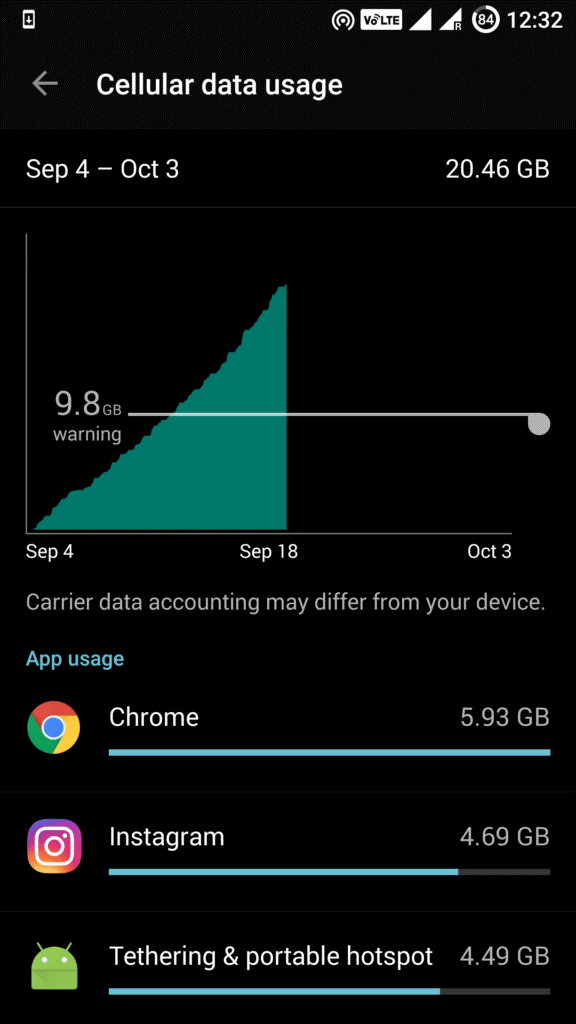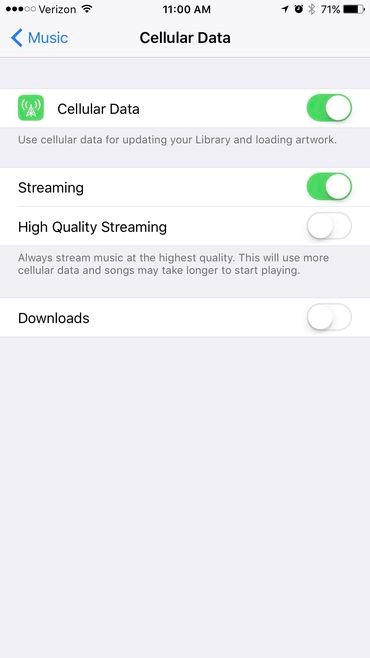Some apps keep consuming mobile data even when the smartphone is not in use. Background data allows you to keep your apps monitored and updated while multitasking or when the screen is off. But every app doesn’t need to use background data at all time.Go to Settings >> Data Usage, and you can see the statistics for which app is consuming how much of data.

Tap on an app, and you can see both the foreground and background data usage for that app. Foreground data usage is the data consumed by the app when it is actively used by you when open. Background data is the data consumed when you are not using the app, and the app is running in the background. It requires no action and occurs automatically. This can include things like automatic app updates or sync.
One of the most effective ways to reduce mobile data consumption is to disable automatic app updates in Play Store. Go to Play Store and tap on >Settings >>Auto-update apps.
Make sure that you select “Auto-update apps over Wi-Fi only.” Alternatively, you can choose “Do not auto-update apps,” but it’s not recommended since you’ll have to remember from time to time to update your apps manually.

The use of data-hungry apps can seriously affect your data consumption while on your mobile network. You may not realize that the Google Photos app might be syncing your photos in the background every time you click one. Social media apps like Facebook and Instagram consume a lot of data. Try to avoid watching videos and GIFs in those apps.
Try to use alternatives to some apps that will still perform the required functions while consuming fewer data. For example, Facebook Lite is a highly lite alternative to the Facebook app. Moreover, it saves battery life and data usage. TweetCaster is a similar option for the Twitter app.
Your account sync settings are set to auto-sync by default. Keep auto-sync disabled for data-hungry apps like Facebook and Google+, which use sync services to sync files like photos and videos, consuming a lot of data in the process.
Google constantly sync’s your data when a change is made. Most of these sync services might not be required. This background sync service affects both your data consumption and battery life.
To adjust your sync setting, go to Settings>>Accounts. There you can fine-tune sync settings for different apps. To optimize Google sync, tap on Google, and turn off the options you don’t require.

Stopping data-hungry apps from eating up your data bundles isn't the only way for iPhone owners to reduce their data usage. Here are seven phone-wide settings that can help you optimize your mobile data usage.
You can prevent iTunes and the App Store from downloading music, movies, apps and so on when you are away from a Wi-Fi signal. To do so, go to Settings > iTunes & App Store and toggle off Use Cellular Data.

Tap this to prevent iTunes from using your cellular data for automatic downloads.
iOS apps can update in the background, grabbing new content as they sit idle so they can show you the latest news when you return to them. Go to Settings > General > Background App Refresh in order to turn this setting off completely. You can also go the a la carte route from the list below and choose which apps update in the background.

Pick and choose the apps that may use data in the background of your phone or turn them all off.
Curious to know which apps are consuming the most data? Go to Settings > Cellular and you can see how much data you've used in the current billing period and below that you'll see a list of your apps. Under each app's name is the amount of data it has used for the current billing period. You can toggle off any app that you think is eating more than its fair share.

See which app is using the most data here.
Wi-Fi Assist is a great feature where your iPhone hands off a weak Wi-Fi signal to your cellular network to prevent pages from loading slowly (or not at all) as it clings to the last remnants of a Wi-Fi signal. If you sit on the edge of a Wi-Fi network at work, say, then your cellular network may be assisting more than you'd like and running up data charges. To disable Wi-Fi Assist, go to Settings > Cellular and scroll all the way to the bottom to turn off Wi-Fi Assist.

Wi-Fi Assist may be eating more cellular data than you would like.
Streaming music or podcasts for long stretches when you are away from Wi-Fi can quickly add to your data usage. Most music and podcast apps (like Spotify and Apple Music) let you restrict streaming to Wi-Fi only, which will then force you into the habit of downloading playlists or podcasts before playing them instead of streaming them over cellular data. Let's look at Apple Music and Apple's Podcasts apps as examples.
For Apple Music, go to Settings > Music. In the Streaming & Downloads section, you'll see two settings if the first is enabled. The first, Use Cellular Data, lets you disable streaming via a cellular connection entirely. If that's too drastic a measure for you, then you can leave that setting enabled and turn off High Quality on Cellular to stream songs at a lower bitrate when you aren't on Wi-Fi.

You can control how the Apple Music app uses data here.
For the Podcasts app, go to Settings > Podcasts and turn off Cellular Data. You can also enable Only Download on Wi-Fi to prevent podcast downloads from adding to your data usage.
Check to see how frequently your email account is set to fetch new mail -- the less frequently it fetches, the less data (and battery) you'll use. Go to Settings > Mail > Accounts > Fetch New Data. First, make sure Push is turned off if you want to save data and don't need new emails pushed to you constantly. Next, see what the schedule is for Fetch at the bottom of the screen. If you choose Manually, then the Mail app will check for new email only when you open the app.

Changing your Fetch schedule could save data, as well as your phone's battery life.
Your iPhone automatically uploads photos to iCloud from time to time. Go to Settings>Photos>Mobile Data and turn this off to restrict uploads to Wi-Fi only.

Because every now and then we need a dose of our favorite YouTubers plus all the interesting content on YouTube, we need a sustainable way to consume the content. Save up to 60% of your data by choosing to watch videos in standard quality instead of High Definition. Here’s how you do this: -
Snapchatting is fun and it gives you access to great content that you don’t want to miss out on before its 24-hour run. Here’s how to ensure that you save on data while on Snapchat: -.
There’s a WhatsApp group for just about anything these days, and we have no control over how many memes we receive per day. To keep your WhatsApp groups from consuming a lot of data, make sure to deactivate auto-download on videos and images: -
STrying to resist the allure of pictures of friends treated to vintage filters is futile. We spend a good amount of time scrolling through Instagram. Here is how to control the amount of data it consumes: -
Videos are more commonly being used to share information, and Facebook made sure to maximize on this new strategy. To ensure that your data survives longer, switch off autoplay through these simple steps: -.
Twitter is where we go to keep up with what’s happening in the world so uninstalling the app isn’t an option. Instead, you may control your data consumption by turning off autoplay on videos through these steps: -